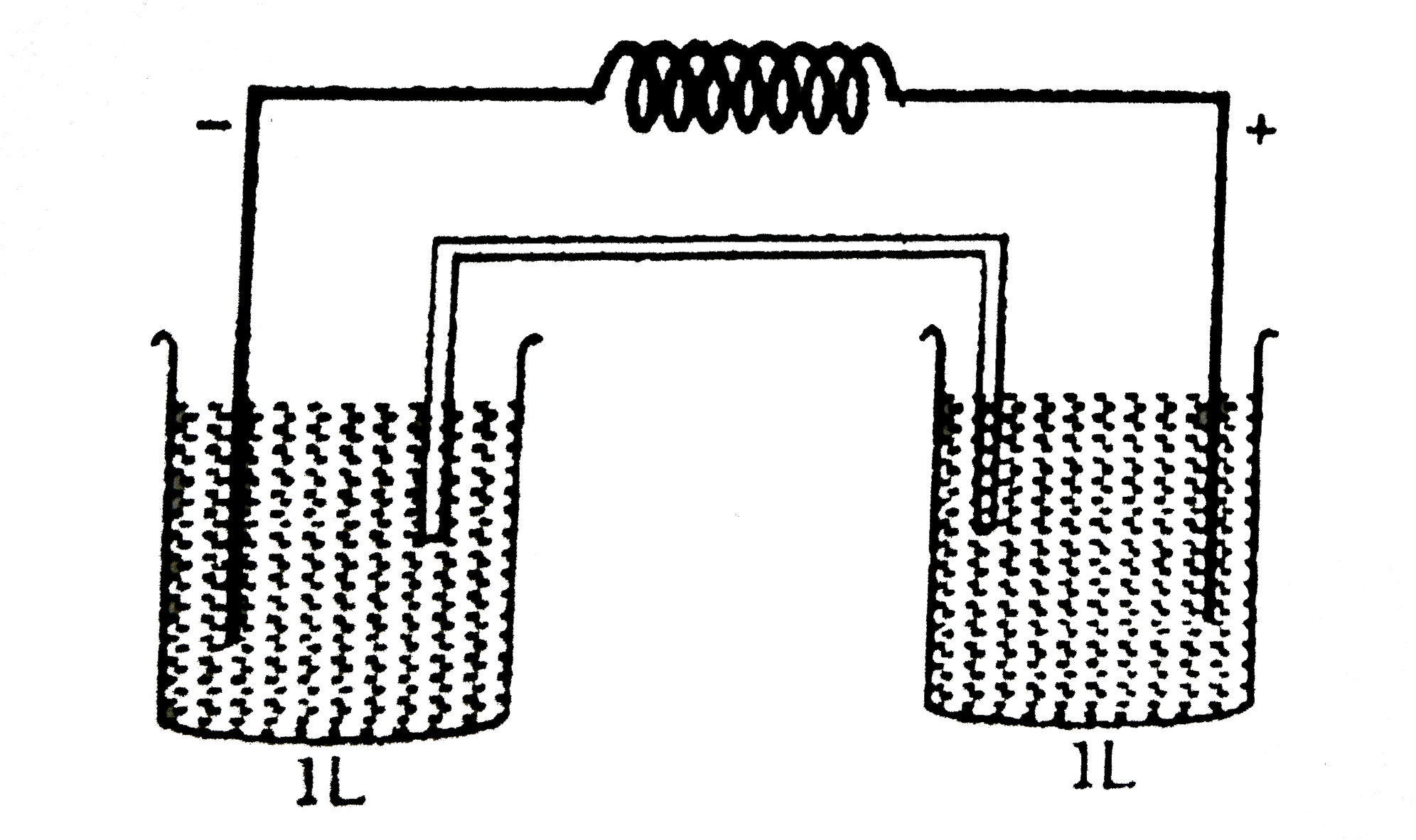Na-Amalgam is prepared by electrolysis of aq. solution using 10gm Hg cathode. How many Faraday's of electricity is required to prepare Na-Amalgam (current Eff
s
s
The correct Answer is:C
To solve the problem of how many Faraday's of electricity is required to prepare an 18.7% Na-Amalgam from the electrolysis of an aqueous NaCl solution using a 10g Hg cathode, we can follow these steps:
Step 1: Understand the Composition of Na-Amalgam
Na-Amalgam is formed when sodium ions (Na⁺) react with mercury (Hg) to form sodium amalgam (Na-Hg). The percentage composition of sodium in the amalgam is given as 18.7%.
Step 2: Calculate the Mass of Sodium in the Amalgam
To find the mass of sodium in the amalgam, we can use the formula for percentage composition:
Mass of Na=Percentage of Na×Total mass of amalgam
Let the total mass of the amalgam be m. The mass of sodium can be expressed as:
Mass of Na=0.187×m
Step 3: Determine the Total Mass of the Amalgam
The total mass of the amalgam consists of the mass of mercury and the mass of sodium:
m=Mass of Hg+Mass of Na
Given that the mass of mercury (Hg) is 10g, we can substitute:
m=10g+0.187m
Rearranging gives:
m−0.187m=10g⟹0.813m=10g⟹m=10g0.813≈12.3g
Step 4: Calculate the Mass of Sodium
Now we can calculate the mass of sodium:
Mass of Na=0.187×12.3g≈2.3g
Step 5: Convert Mass of Sodium to Moles
Using the molar mass of sodium (Na = 23g/mol):
Moles of Na=2.3g23g/mol≈0.1 moles
Step 6: Calculate the Charge Required
According to Faraday's first law of electrolysis, the charge (Q) required to deposit 1 mole of sodium is 1 Faraday (F). Therefore, for 0.1 moles of sodium:
Charge (Q)=0.1 F
Step 7: Adjust for Current Efficiency
Since the current efficiency is given as 50%, we need to adjust the charge required:
Effective charge required=QEfficiency=0.1 F0.5=0.2 F
Final Answer
Thus, the total charge required to prepare the 18.7% Na-Amalgam is 0.2 Faraday.
---
Na-Amalgam is formed when sodium ions (Na⁺) react with mercury (Hg) to form sodium amalgam (Na-Hg). The percentage composition of sodium in the amalgam is given as 18.7%.
To find the mass of sodium in the amalgam, we can use the formula for percentage composition:
Mass of Na=Percentage of Na×Total mass of amalgam
Let the total mass of the amalgam be m. The mass of sodium can be expressed as:
Mass of Na=0.187×m
The total mass of the amalgam consists of the mass of mercury and the mass of sodium:
m=Mass of Hg+Mass of Na
Given that the mass of mercury (Hg) is 10g, we can substitute:
m=10g+0.187m
Rearranging gives:
m−0.187m=10g⟹0.813m=10g⟹m=10g0.813≈12.3g
Now we can calculate the mass of sodium:
Mass of Na=0.187×12.3g≈2.3g
Using the molar mass of sodium (Na = 23g/mol):
Moles of Na=2.3g23g/mol≈0.1 moles
According to Faraday's first law of electrolysis, the charge (Q) required to deposit 1 mole of sodium is 1 Faraday (F). Therefore, for 0.1 moles of sodium:
Charge (Q)=0.1 F
Since the current efficiency is given as 50%, we need to adjust the charge required:
Effective charge required=QEfficiency=0.1 F0.5=0.2 F
Thus, the total charge required to prepare the 18.7% Na-Amalgam is 0.2 Faraday.
Topper's Solved these Questions
- ELECTROCHEMISTRYBook:ALLENChapter:ELECTROCHEMISTRYExercise:EXERCISE-02
Explore 35 Videos
- ELECTROCHEMISTRYBook:ALLENChapter:ELECTROCHEMISTRYExercise:EXERCISE-03
Explore 24 Videos
- ELECTROCHEMISTRYBook:ALLENChapter:ELECTROCHEMISTRYExercise:INTEGER TYPE
Explore 18 Videos
- CHEMISTRY AT A GLANCEBook:ALLENChapter:CHEMISTRY AT A GLANCEExercise:ORGANIC CHEMISTRY
Explore 472 Videos
- HYDROCARBONBook:ALLENChapter:HYDROCARBONExercise:MCQ
Explore 15 Videos
Similar Questions
Na− amalgam is prepared by electrolysis of NaCl solution using liquid Hg as cathode . How long should the current of 10amp. Is passed to produce 10%Na−Hg on a cathode of 10gmHg. ( atomic mass of Na=23).
View SolutionNa-amalgam is prepared by electrolysis of NaCl solution using liquid Hg as cathode. How long should the current of 10 amp. Is passed to produce 10% Na-Hg on a cathode of 10 gm Hg. (atomic mass of Na=23).
(A). 7.77 min
(B). 9.44 min.
(C). 5.24 min.
(D). 11.39 min
View Solution
Knowledge Check
Chemical reactions involve interaction of atoms and molecules. A large number of atoms and molecules (approximately 6.022×1023) are present in a few grams of any chemical compound varying with their atomic/molecular masses. To handle such a large number conveniently, the mole concept was introduced. This concept has implications in diverse areas such as analytical chemistry, biochemistry, electrochemistry adn radiochemistry. The following examples illustrate a typical case involving chemical/electrochemical reaction which requires a clear understanding of mole concept.
A 4.0 molar aqueous solution of NaCl is prepared and 500 mL of the solution is electrolysed. This lead to the evolution of chlorine gas at one of electrodes (atomis mass : Na = 23 , Hg = 200 , 1F = 96500 C)
If the cathode is a Hg electrode, the maximum weight (g) of amalgam formed from the solution is :A200B225C400D446
Cd amalgam is preapred by electrolysis of a solution CdCI2 using a mercury cathode. How long should a current of 5A be passed in order to prepare 12%Cd−Hg amalgam on a cathode of 2g,Hg( atomic weight of Cd=112.4)
View SolutionCadmium amalgam is prepared by electrolysis of a sodium of CdCl2 using a mercury cathode. How long should a current of 4 A be passed in order to prepare 10% by mass Cd in Cd-Hg amalgam on cathode of 4.5 g Hg? (atomic mass of Cd=112)
View SolutionZn amalgam is prepared by elctrtolysis of aqueous ZnCI2 using 9 gram Hg cathode how much current is to be pased through ZnCI2 solution for 1000 seconds to prepare a Zn amalagam with 25% by weight ? (atomic masss Zn =65.4 g)
View SolutionAmmonium perchlorate, NH4ClO4 , used in the solid fuel in the booster rockets on the space shuttle, is prepared from sodium perchlorate, NaClO4 , which is produced commercially by the electrolysis of a hot, stirred solution of sodium chloride. How many faradays are required to produce 1.0kg of sodium perchlorate?
NaCl+4H2O→NaClO4+4H2
View SolutionHow many gram of sodium hydroxide pellets containing 12% moisture are required to prepare 60 litre of 0.5N solution.
View SolutionOne litre each of a Buffer solution is taken in two beakers connected through a salt bridge. Platinum electrode is immersed in each beaker and electrysis is carried out for 10,000 sec. using a current of 9.65 Ampere. The Buffer contain 13 mole each of Na2HPO4 and NaH2PO4 Initially. using the given data answer the following.

Given: ltbr> pKa(H3PO4)=4,pKa(H2PO−4)=7,pKa(HPO2−4)=10
log2=0.3,log3=0.48
2.303RTF=0.06at298K
What is pH of solution in which reduction taken place during electrolysis.
View SolutionOne litre each of a Buffer solution is taken in two beakers connected through a salt bridge. Platinum electrode is immersed in each beaker and electrysis is carried out for 10,000 sec. using a current of 9.65 Ampere. The Buffer contain 13 mole each of Na2HPO4 and NaH2PO4 Initially. using the given data answer the following.

Given: ltbr> pKa(H3PO4)=4,pKa(H2PO−4)=7,pKa(HPO2−4)=10
log2=0.3,log3=0.48
2.303RTF=0.06at298K
What is the pH of compartement in which oxidation taken place during electrolysis.
View Solution